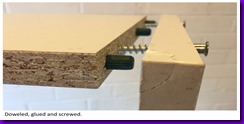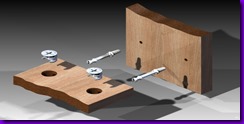What makes a good kitchen unit? The first thing to make sure of when you are considering buying kitchen units is panel thickness. They should be 18mm thick including the back panel but many cheaper kitchen units are often 16mm thick with an 8mm back panel. Not a lot of difference you might say for the extra money you might save but in the long term you would notice the difference – fixings and hinges coming loose, doors sagging, drawers catching – all common issues associated with a cheap carcase. Other things to bear in mind when purchasing kitchen units are: Edging- especially the front edge of the cabinet, the most vulnerable part of the unit where you are liable to catch it with a plate or pan. Construction – how it is put together, the quality of mechanical things, hinges/drawer boxes etc.
Firstly the edging – cheap kitchen units will normally have an iron on melamine edging which is susceptible to chipping if banged, the better quality cabinets have at least a 0.9mm PVC edging all around which is bonded to the carcase and even better cabinets will have a 2mm front edge, a much sturdier edging that will definitely protect from impact.
 Secondly construction, a cheap cabinet will simply be glued, doweled and screwed together (see left ), So what? – you ask. Well, if this has been pre-assembled and sold as a rigid kitchen ( I will get on to those soon!), and the assembler was having a bad day the chances of the unit being square and plumb are slim to none and rectifying this issue on site is made very difficult. The best form of construction is to use the cam and dowel system – wooden dowels secured in holes with two sets of metal studs and cams. These are essentially discs that, once inserted into the holes and turned 90 degrees, secure the dowel in place but importantly no gluing is required and if necessary the unit can be taken apart.
Secondly construction, a cheap cabinet will simply be glued, doweled and screwed together (see left ), So what? – you ask. Well, if this has been pre-assembled and sold as a rigid kitchen ( I will get on to those soon!), and the assembler was having a bad day the chances of the unit being square and plumb are slim to none and rectifying this issue on site is made very difficult. The best form of construction is to use the cam and dowel system – wooden dowels secured in holes with two sets of metal studs and cams. These are essentially discs that, once inserted into the holes and turned 90 degrees, secure the dowel in place but importantly no gluing is required and if necessary the unit can be taken apart.
This leads us nicely to the question of rigid( pre-constructed) or flat pack (ready to assemble) units. I think a lot of companies have tried to demonise the good old flat packed kitchen and I think it is unwise to dismiss them completely. What are the pros and cons? In reality all the pros of the rigid kitchen seem to be in aiding the installation of the unit, on paper it saves time for the installer as he is not spending time building them up – What if your walls are not level? What if a unit has to be modified on site? What if the unit is not square? All these issues are a reality and if the unit can’t be modified on site the fitter will be hanging around waiting for a replacement etc resulting in delays and frustrated customers! So, the pros of a flat packed kitchen( so long as the units have the specifications already discussed) are – easier to modify and also easier to store – Have you got enough room to store a rigid kitchen? Will it be easy enough to get bulky or tall units into your property? On balance I think there is a lot to say for the good quality flat packed kitchen but sadly a lot of manufactures are favouring the rigid kitchen. Luckily for us, we still have the option of both.
Live well, Buy well
